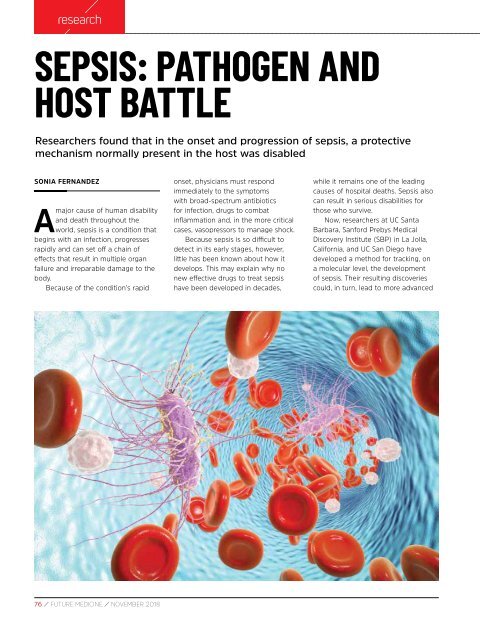Create successful ePaper yourself
Turn your PDF publications into a flip-book with our unique Google optimized e-Paper software.
esearch<br />
SEPSIS: PATHOGEN AND<br />
HOST BATTLE<br />
Researchers found that in the onset and progression of sepsis, a protective<br />
mechanism normally present in the host was disabled<br />
SONIA FERNANDEZ<br />
A<br />
major cause of human disability<br />
and death throughout the<br />
world, sepsis is a condition that<br />
begins with an infection, progresses<br />
rapidly and can set off a chain of<br />
effects that result in multiple organ<br />
failure and irreparable damage to the<br />
body.<br />
Because of the condition’s rapid<br />
onset, physicians must respond<br />
immediately to the symptoms<br />
with broad-spectrum antibiotics<br />
for infection, drugs to combat<br />
inflammation and, in the more critical<br />
cases, vasopressors to manage shock.<br />
Because sepsis is so difficult to<br />
detect in its early stages, however,<br />
little has been known about how it<br />
develops. This may explain why no<br />
new effective drugs to treat sepsis<br />
have been developed in decades,<br />
while it remains one of the leading<br />
causes of hospital deaths. Sepsis also<br />
can result in serious disabilities for<br />
those who survive.<br />
Now, researchers at UC Santa<br />
Barbara, Sanford Prebys Medical<br />
Discovery Institute (SBP) in La Jolla,<br />
California, and UC San Diego have<br />
developed a method for tracking, on<br />
a molecular level, the development<br />
of sepsis. Their resulting discoveries<br />
could, in turn, lead to more advanced<br />
76 / FUTURE MEDICINE / <strong>NOVEMBER</strong> <strong>2018</strong>


















